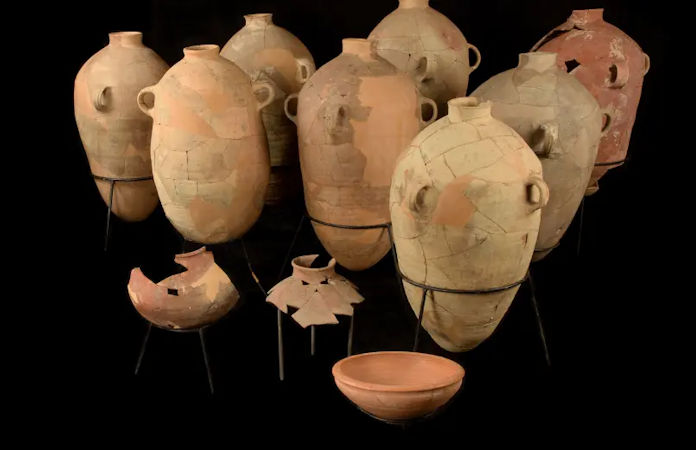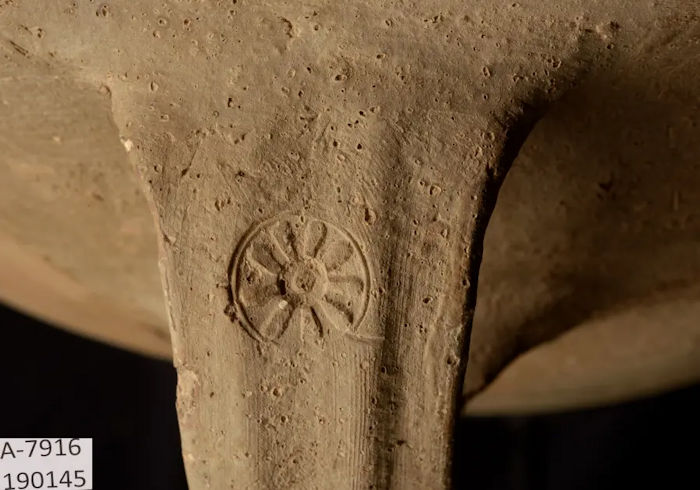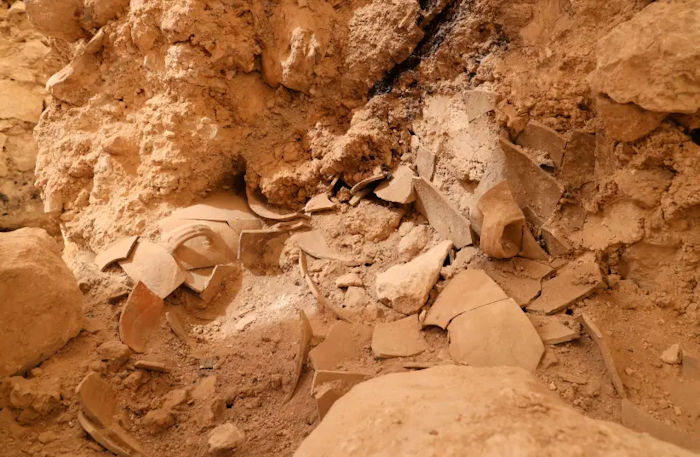Conny Waters – AncientPages.com – While examining the sides of 15 ceramic jars, used for wine and olive oil storage in two buildings in the City of David, in Israel, archaeologists discovered some of them contained 2,600-year-old remnants of vanilla.

Collection of wine jars after the restoration process. Credit: Dafna Gazit, Israel Antiquities Authority
The buildings dating back to the First Temple period were destroyed during the Babylonian destruction of Jerusalem in 586 BC. However, archaeologists were able to recover fragments of the jars left inside.
In a newly published study in the journal PLOS ONE, researchers from the IAA and Tel Aviv University report they were surprised to find organic residues of the exotic, expensive spice on wine jars. The finding suggests that the Old Testament residents of Jerusalem enjoyed seasoning their wine with the spice about 2,600 years ago.
“Five of the jars bear rosette stamp impressions on their handles, indicating that their content was related to the kingdom of Judah’s royal economy. The identification of the original contents remains is significant for the understanding of many aspects related to the nutrition, economy, and international trade in the ancient Levant.
The study shed light on the contents of the jars and the destruction process of the buildings in which they were found. The jars were used alternatively for storing wine and olive oil. The wine was flavored with vanilla.

Seal impression in the shape of a rosette is visible on the ancient jar. Credit: Israel Antiquities Authority
These results attest to the wine consumption habits of the Judahite elite and echo Jerusalem’s involvement in the trans-regional South Arabian trade of spices and other lucrative commodities on the eve of its destruction by Nebuchadnezzar,” the scientists write in their paper.
“The process of “oaking” – the aging of wines in barrels made from oak – which has been around since Roman times imparts an understated vanilla note to wine due to the vanillin chemical compound found in oak. However, the Israeli researchers say their analysis of the residue found three different molecules, which together indicate a fingerprint from vanilla itself, leaving no doubt of the origins of the residue,” the Jerusalem Post reports.
“Vanilla markers are an unusual find, especially in light of the fire that occurred in the buildings where the jars were found,” said Ayala Amir, a doctoral student in the Department of Archeology and Ancient Near Eastern Cultures at Tel Aviv University.
“The results of the analysis of the organic residues allow me to say with confidence that the jars contained wine and that it was seasoned with vanilla.”
Considering that a large number of jars were found, archaeologists the place might have been a wine cellar in an impressive two-story building that served as a bureau of senior officials in the kingdom.
“Other vessels for storing liquids, including a very large one, were also found in the room that was so crowded that researchers said it would have been very hard for people to move around inside it,” the Jerusalem Post reports.
“These finds tell us that the residents of Jerusalem in the late seventh century BCE in this area were people of means, with money, who were connected to international trade and the South Arabia trade. They could allow themselves the prestigious things of life that were available then, and were connected to the trends of the day. I don’t know what the wine tasted like then, but it certainly was considered high quality at the time,” Dr. Yiftah Shalev who participated in the excavation said.

As many as 15 ancient jars were discovered. Credit: Israel Antiquities Authority
As explained by the Jerusalem Post, “Social events and ceremonies that included drinking wine were also common then in many other cultures in Greece and Eastern empires. It is mentioned numerous times in the Bible, such as in Psalms 104:15, where God is blessed as the creator of “wine, which cheers man’s heart,” and in Amos 6:1-7, as the Prophet Amos rebukes “the complacent in Zion… You lie on beds adorned with ivory and lounge on your couches… You drink wine by the bowlful.”
Seal impressions in the shape of a rosette appear on the handles of some of the jars, indicating that they and their contents were part of the royal administration of the Kingdom of Judah, the researchers said, and that the number of jars and impressions on them point to the economic importance of wine, and the drinking culture, as a tool for expressing status and power.
See also: More Archaeology News
“These jars were part of the taxation system common throughout Judea in the seventh century BCE,” said Shalev.”
Recently scientists announced it may be possible to reconstruct ancient scents with help of modern technology. Such a breakthrough would give scientists the opportunity to smell the vanilla remnants found in the ancient jars unearthed in Old Jerusalem.
The study was published in the journal PLOS ONE
Written by Conny Waters – AncientPages.com Staff Writer





